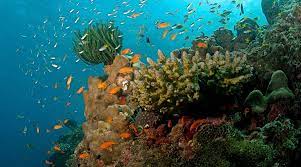CURRENT AFFAIRS
Get the most updated and recent current affair content on Padhaikaro.com
Global Coral Reef Monitoring Network and its report
- Vaid's ICS, Lucknow
- 06, Oct 2021

GS Paper II
Topics Covered: Conservation and Pollution related issues.
Context:
Global Coral Reef Monitoring Network (GCRMN) has released a report on the status of coral reefs across the world.
- The report, the first of its kind in 13 years, underlined the catastrophic consequences of global warming but said that some coral reefs can be saved by arresting greenhouse gases.
Highlights of the report
- In the last decade, the world lost about 14 per cent of its coral reefs.
- Threats:Ocean-acidification, warmer sea temperatures and local stressors such as overfishing, pollution, unsustainable tourism and poor coastal management.
- Impact of global warming:Coral reefs across the world are under relentless stress from warming caused by climate change. Coral bleaching events caused by rise in elevated sea surface temperatures (SST) were responsible for coral loss.
- Loss of hard coral cover:There has been a steady decrease in hard coral cover in the last four decades since 1978 when the world lost nine per cent of its corals. The decrease is disconcerting because live hard coral cover is an indicator of coral reef health.
- Algal bloom:Algal bloom on coral ridges are a sign of stress on the structures. Since 2010, the amount of algae on the world’s coral reefs has increased by about 20 per cent.
Why conserve corals?
- Corals occupy less than one per cent of the ocean floor but over one billion people benefit directly from the reefs.
- The value of goods and services provided by coral reefs is estimated to be $2.7 trillion per year. This includes $36 billion in coral reef tourism.
- The net economic value of the world’s coral reefs could be nearly tens of billions of dollars per year.
Challenges ahead:
- Persistent rise of land and sea temperatures is a threat to corals.
- The survival of corals is likely to drop below 50 per cent if sea surface temperatures increase by one degree.
- All of the world’s reefs will bleach by the end of the century unless the world acts together to reduce carbon emissions.
What is bleaching?
Basically bleaching is when the corals expel a certain algae known as zooxanthellae, which lives in the tissues of the coral in a symbiotic relationship.
- About 90% of the energy of the coral is provided by the zooxanthellae which are endowed with chlorophyll and other pigments.
- They are responsible for the yellow or reddish brown colours of the host coral. In addition the zooxanthellae can live as endosymbionts with jellyfish also.
- When a coral bleaches, it does not die but comes pretty close to it. Some of the corals may survive the experience and recover once the sea surface temperature returns to normal levels.
Facts for Prelims
‘Swechha’ programme
- It is an awareness drive on menstruation launched recently by Andhra Pradesh government.
- It has been launched in all government schools and colleges.
- Under the programme, sanitary napkins would be provided to over 10 lakh students studying in Classes 7 to 12.
Health Information Management System (HIMS) project
- The Delhi Cabinet gave financial nod to its ambitious Health Information Management System (HIMS) project. As part of the project, each citizen will have a health card, which will be a repository of their medical information.
- The government said doctors will be able to see a patient’s medical history using the card and the patients will be able to make appointments from home.
- All citizens between 1 and 18 years would be issued a health card linked to their parent’s health card. All newborns (up to 1 year) would be linked to their mother’s health card.